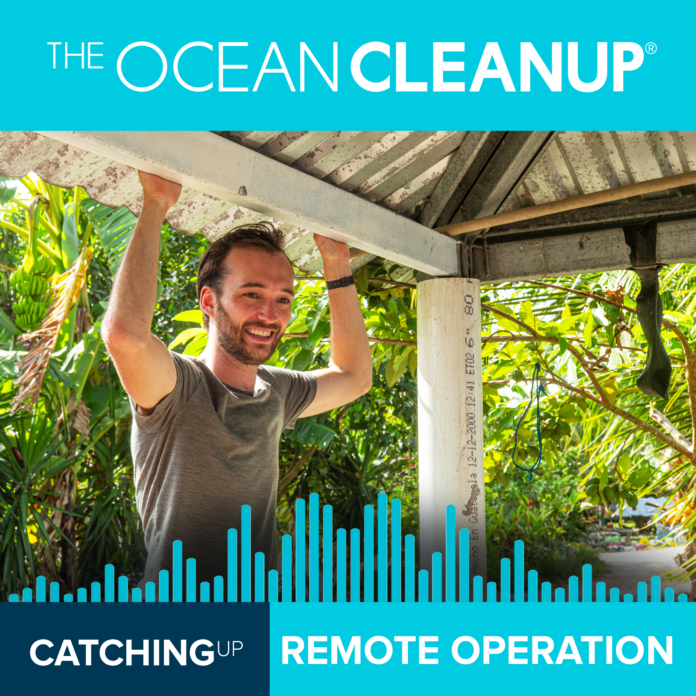Dan: For those keeping score, this is what we call Interceptor Barricade XL number 021. Give me some of the facts about this barricade and how we came to this. As you mentioned, we have Interceptor 006 in the Las Vacas just north of Guatemala City in San Antonio, Las Flores, which has been quite a success. And our relationship with Worthington that we worked with for this project up in Las Vacas, we’ve worked with them again on this. Right? But at a different scale from what I understand?
Bobby: Exactly. So, the scale part, if you compare this location to the one in Las Vacas, there are differences in how the river behaves. In Las Vacas, we have very intermittent flow, sometimes very violent, very extreme, and so there’s a big difference with this place, where it’s more graduate and equal throughout the year. It can grow quite a lot, but there’s always flow here, so there’s also always plastic. And because we’re at the very end of the river, there’s also a lot of plastic here, and the river is very wide. You can see all the tributaries end up here. So there’s approximately 110, 120 meters to the other side, so that requires a bigger barrier. Whereas in Las Vacas, it needs to be very sturdy because it’s bouncing around in turbulent water, sometimes resting on the riverbed; this one will always be floating, but also always be in the flow. So this one is of similar build but slightly larger, and there are a few structural changes. Those are the main differences, but the principle is the same. We have two very large marine anchors upstream and downstream that connect a chain and a cable to which all the elements are attached. Another difference is that this one has a very large front screen, and that’s needed because while in Las Vacas, you can reach the middle of the barrier with the excavator, but here, that’s impossible. So we must make sure that nothing sticks to the barrier; everything slides by the force of the flow to the sides. We’ll also have an excavator here taking it out, but we can’t go out onto the river to untangle stuff. So that’s why we have a smoother surface; that’s the idea behind it. Worthington is our design partner; they also manufactured it. They placed one of this type earlier, and it seemed to be working there. So this one will do its job for sure, the question is, how well will it do its job? It remains to be seen.
Dan: Stay tuned. Now, Bobby, explain to me that if we have closed the Las Vacas up in Guatemala City, why do we need this second intervention down at the mouth of the Motagua? Is there that much trash coming, 300 kilometers from Guatemala City to the mouth of the Motagua?
Bobby: There is. There are a couple of reasons, actually. So one of them is that in Las Vacas, the flash floods, as you see with the trash fence in the videos of 006, it can be so violent that the barrier can’t stop all. The barriers might overtop, the flow might push plastics under, so we lose stuff, unfortunately, and that all eventually ends up here. Another point is that we have other cities and other points of pollution along the 300-kilometer river stretch. So, even if we would catch everything in Las Vacas, there would still be debris floating down here. And there is the legacy plastic, the plastic that washes up at high tide on the river banks, and it might stay there for a month or a year, and 300 kilometers is long. So even if we were to close Las Vacas and stop all the incoming sources, there would still be quite a significant amount of trash coming with every high water level. So, we’re not done here yet, and it will be coming for some time. This is a good place because it’s very close to the sea. So there are no pollution points between here and the sea, which means that everything we catch here, that has no chance of going anywhere anymore. And hopefully, behind this barrier, we’ll get a clean river going into the sea. That’s the main advantage of being so remote in this place.
Dan: This is, of course, the first time we’ve ever put something of this scale in a river. So I’m certain that there’s things that will happen that we can’t even imagine yet, right?
Bobby: Probably. There always will be something that we need to adjust or align a bit more. Is the structure behaving as it should be? Is the location where it should be? We have an upstream and downstream part that needs to be aligned with the current structure you see behind here, the extraction point. If that’s not properly aligned, we might lose some plastics. So that’s going to be a very big focus point to make sure that the whole gap is closed; there’s nothing that can escape. But once it’s here, it must also not be loose when there’s a flush at night. Another one will be the boat passage. There are a lot of fishermen going in and out, and they need to be able to pass. Now, the water is pretty high or, let’s say, average today. In the dry season, it might get lower, and boats must still be able to pass. So that’s one that we’ll be looking at in the coming months. And, of course, the fishermen are probably very much involved in how this barrier will behave, and they’ll come up with all kinds of ideas. So it will probably be a big focus, talking with them, seeing how they see it behaves. They have been constructing their own barrier after this one failed, to continue catching plastic. It’s a livelihood for them now. So, I’m sure they’ll be very happy with this one, but if there’s anything not working, that will be a first starting point, to see what they think. If there’s anything not working or not working as they would like, we’ll work together to solve that.
[ad_2]
Source link



